THE NEXT BEST ROAD BIKE SHOES

The best road bike shoes deliver a superior combination of power transfer, fit, comfort, and looks.
Getting all that in one pair of shoes comes at a price, typically north of US$400, £350, €400.
Some of us can’t wrap our heads, or our wallets, around spending that much, even after considering the added speed and enjoyment we can get out of a pair of the best shoes compared to less expensive ones that may be some combination of less stiff, well-fitting, or comfortable, and not as good looking.
To help you assess the price-performance trade-offs when considering new road bike shoes, I set out to determine how the next best, less expensive models from three brands compare to their higher-priced siblings that we’ve ranked among the best and to each other.
The Shimano RC903, Specialized S-Works Torch, Trek RSL Knit, and Trek RSL Road shoes rank at the top of our review of the best road bike shoes from over a dozen brands we’ve tested.
Over six months, I rode the Shimano RC703, Specialized Torch 3.0, and Trek Velocis road bike shoes. Each is just one step below its sibling in their brand’s shoe model hierarchy.
These next best shoes still have many design and aesthetic characteristics that serious roadies look for, including stiff soles, dual Boa dials, and quality materials.
But they’re priced around US$250, £220, €250, or about 60% of the top-performing models.
To be clear, the Shimano RC703, Specialized Torch 3.0, and Trek Velocis are not simply lower-priced, less-promoted, most-of-what-you-need options to their more heralded and more expensive siblings that wave the top-of-the-range S-Phyre, S-Works, and RSL banners.
Instead, I found that the fit, comfort, and style of these next best road bike shoes are different enough from those of their best road bike shoe siblings and each other in important ways. That makes choosing between them a decision that needs to be based on more than their brand and price.
In this review, I’ll tell you about those differences and try to share enough to help you decide whether the price-performance trade-off is worth it.
Shimano S-Phyre RC903 and RC703
Shimano’s S-Phyre RC903 is one of our highest-rated and one of my two personal favorite road bike shoes. It has it all – a wonderfully sculpted heel cup, smartly placed top-tier Boa dials, laces, and guides, and goldilocks levels of toe box room, ventilation, and insole arch pad options.
The result is a comfortable, glove-like fit that, along with the unbendable outsole you get with all of the best road bike shoes, makes for exceptional power transfer for road racers and efficient comfort for long-distance riders.
In my opinion, its sleek lines are pretty attractive, and its distinctive blue and other glossy colorways really pop.
You can read my full review of the S-Phyre RC903 by clicking on the model name.
The Shimano RC703 shares some important DNA with the S-Phyre RC903.
Perhaps most importantly, the shoe’s last or mold seems the same. I sensed no difference from the toe box room back through the heel cup width.
I also couldn’t tell any difference between the outsole stiffness of the S-Phyre RC903, which Shimano rates a 12 on its unexplained scale – all cycling shoe manufacturers are guilty of this – and the 10 rating it gives the RC703.
The Boa closure system and its dial, lace, and guide placement differ slightly. Both use the Boa dials that you push down to engage and pull up to release.
But, while you can turn the S-Phyre RC903 dials out to tighten and in to loosen the lace tension, the RC703 dials only turn out to tighten. You have to pull up the dial to loosen the tension.
The S-Phyre RC903 dials are also a little taller and have a more tactile circumference finish than those on the RC703. That makes them a bit easier to turn.
There are several other notable differences between the two models that, for me and perhaps for you, do affect the price-performance considerations and choice between them.
Comfort – I found the RC703 less comfortable than the S-Phyre RC903 during the summer months. The RC703’s uppers are made of a thicker, less pliable material. While the two models share the same pin-hole ventilation pattern, there’s a smaller mesh area above the middle toes for heat to escape in the RC703.
Below your toes, the S-Phyre RC903 has a cutout in the carbon sole covered by a fine wire mesh screen and comes with insoles with an array of holes aligned with the cutout. The shoes also have a small cutout under your heel without any covering, but with a similar array of insole vent holes.
The toe and heel sole cutouts on the RC703 are similarly sized, but the rubbery covering near the toes has a less open area. The insoles that come with the RC703 also have perforations to allow venting, but the soles offer no arch support.
Unless you don’t need that support, you’ll have to get aftermarket insoles and drill out vent holes.
These design differences in the upper material, mesh area above your toes, and outsole cutouts may explain why my feet felt warmer in the RC703 on hot or humid summer days.
On cooler days, ventilation is not an issue.
Staying with the comfort theme for a moment, if you have pronounced or sensitive muscles and tendons that run between your ankles in the front or anterior area of your legs (anterior tibial muscles and tendons), you know the feeling when a long or stiff shoe tongue rubs up against them.
Thanks to the randomness of my anatomy, I have that issue with just my right leg and find some shoes far less comfortable than others for this reason.
Shimano is apparently on to this, at least with the S-Phyre RC903. Those shoes have a pliable, rubbery edge at the end of the upper with a clever set of ribs and a mating friction pad to keep the crossover strap from sliding up toward your ankle.
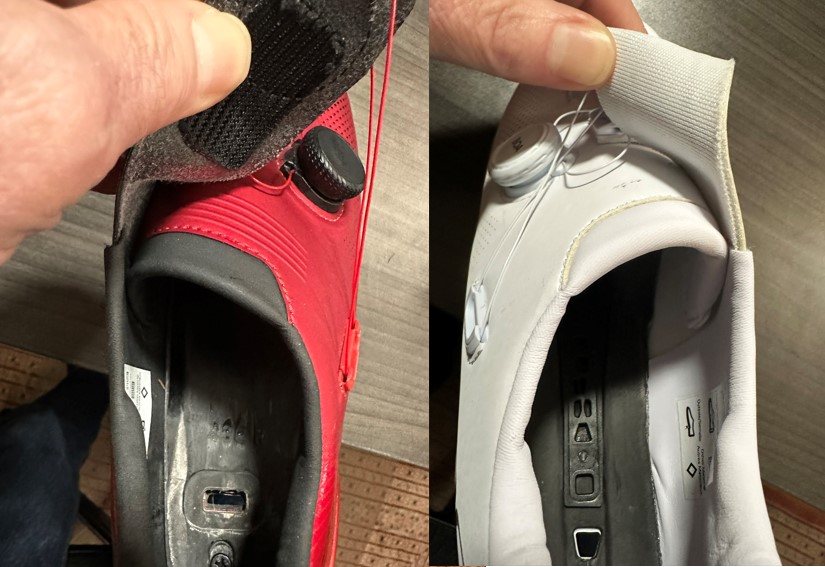 In contrast, the RC703 has a stiffer, leather-like edge and nothing clever (or at all) to keep the flap from sliding up except tightening the Boa dial down more. I got used to the feeling, but I didn’t love it.
In contrast, the RC703 has a stiffer, leather-like edge and nothing clever (or at all) to keep the flap from sliding up except tightening the Boa dial down more. I got used to the feeling, but I didn’t love it.
Fit – The S-Phyre RC903 comes with insoles that you can add medium or tall pads to for added arch support. While I still prefer my Specialized Body Geometry after-market insoles in most shoes, I find the Shimano insoles are nearly as good and use them most of the season in my S-Phyres.
Shimano doesn’t appear to sell just S-Phyre RC903 insoles and wedges separately to put them in the RC703s.
Instead, plan on spending about $40 for Body Geometry or Superfeet insoles and drilling out some vent holes to align with those in the shoe’s outsole.
Durability – While I’ve not ridden the RC703 long enough to rate its overall durability or how its uppers may wear compared to those on the S-Phyre RC903, I’ve already experienced the added scuffing around the outsides of its heel cups. There’s a far smaller cap around this area of the RC703 shoes than on the S-Phyres.
Style – The key difference between the two models is the choice of colorways and their finish. While Shimano often adds “special edition” colorways to its shoe lines, the RC703 was introduced in matte black, matte white, and a semi-gloss sage green option.
In contrast, the S-Phyre RC903 is blingier both with its choice of colors and the glossy finish on most of the uppers and the protective heel cup.
Bottom line – If you like a glove-like fit with ample toe box room in your road bike shoes, don’t ride in hot weather, and are willing to give up some styling to save a big chunk of change, the RC703 is a solid alternative to the S-Phyre RC903.
At US$250, £220, €290, you’ll save US$200, £130, €60 compared to Shimano’s best road bike shoes.
You can order the RC703 using these links to BTD (BikeTiresDirect) 10% off w/code ITK10 and Competitive Cyclist.
If you prefer the Shimano S-Phyre RC903, you can order them with these links to BTD (BikeTiresDirect) 10% off w/code ITK10, Competitive Cyclist, Performance Bicycle, and Sigma Sports.
In The Know Cycling is ad-free, subscription-free, and reader-supported. If you want to help keep it rolling without any added cost to you, buy your gear and kit after clicking the store links on the site. When you do, we may earn an affiliate commission that will help me cover the expenses to create and publish our independent, comprehensive, and comparative reviews. Thank you, Steve. Learn more.
Specialized S-Works Torch and Torch 3.0
Despite the high-level performance and broad acceptance among fellow enthusiasts of the S-Works 6 and 7 road bike shoes, Specialized significantly changed the last and several other key fit and comfort characteristics with its latest S-Works Torch shoes.
Key among them, Spesh seems to have applied the “go big or go home” alpha male saying to the design of the S-Works Torch. The shoe feels a half size longer than the earlier two models, its toe box is rounder, and it’s as roomy as any of the best road bike shoes we’ve tested from a dozen brands.
There’s enough room up front for your piggies to party in the S-Works Torch, a welcome invitation on long rides and hot days.
The width at the forefoot and heel cup also increased with the S-Works Torch compared to the S-Works 7.
Continuing with this roomier S-Works Torch design, Specialized got rid of the Velcro strap that was intended, unsuccessfully in our experience, to snug the shoe’s width just beyond the balls of your feet. Consistent with the roomier theme of the new last, they didn’t extend the lower Boa wire laces and guides to do a better job of what that strap was originally designed to do.
Specialized also moved the upper Boa wire guide from the middle to the outside of your foot and removed a lot of the upper material over the tongue.
To top off all these changes, the S-Works Torch replaced the Dynema upper of the S-Works 6 and 7 with a more supple and breathable one that rivals leather and knit shoes for comfort.
My fellow tester, Nate, a veteran of the S-Works 6 and 7, loves all the changes in the S-Works Torch. His feet also don’t get as warm as mine on hot summer days in these latest Specialized road bike shoes, despite going without the large outsole vents under the arches the S-Works 7 had.
He especially applauds the S-Work Torch’s wider heel cup and the shorter edges below your ankles that make it easier to get your feet in and out of the shoes, but still keep your heels down on your upstroke.
While we both wear the same size shoes, and my feet are a few millimeters longer and wider than Nate’s, I don’t like the lateral movement I experienced in the S-Works Torch’s wider heel cup that led to blistering during my testing.
The unique dials Boa has supplied Specialized for its last few S-Works shoes feel wonderful between your fingers and make ever-so-slight micro-adjustments to tune your fit.
And while Nate has gotten used to but doesn’t love them, I fault these dials for requiring you to unwind them to fully release the tension rather than being able just to pull them up when it’s time to get your feet out.
I also wish the lower wire and guide went to the base of your forefoot to allow me to sync up that part of the shoes.
In contrast, I happily wear the Specialized Torch 3.0 during the spring and fall.
Not only is it priced USD$200 less than the S-Works Torch, but the Torch 3.0 wins me over with features that prevent me from enjoying all the other goodness of the S-Works.
Heel Cup – The Torch 3.0’s heel cup isn’t nearly as wide as the one in the S-Works Torch. It follows the shape of your heel – wider at the bottom, narrower at the top – and uses comfortable padding in the upper half to keep your heels in place. Recalling how much my heels floated (and blistered) in the S-Works Torch, I actually smile when my heels drop snugly into place in the Torch 3.0.
Boa Dials – The Torch 3.0 uses Boa S2 dials that allow you to tighten the shoes by turning the dials outward and loosen them by turning them inward. You also merely pull up the dial to fully release the tension, unlike the S-Works Torch dials that don’t have this option, instead requiring that you fully unwind the dials to extract your feet.
Uppers – While the shoes don’t have any ventilation slots below your feet and only pinholes above them, the uppers are made of tough TPU (thermoplastic polyurethane) with a braided texture. The material isn’t as supple or breathable as what Specialized uses on the S-Works Torch. Its stiffness causes the outside edge above the tongue to pucker below the lower dial.
It has resisted scuffs quite well, however, and I expect it will be durable over the long term.
If your feet don’t prefer as much ventilation as mine do during the summer, the Torch 3.0 can be year-round shoes. There’s also enough room to wear a thicker sock without any change in comfort.
Soles – While I expect they measure differently, the Torch 3.0 carbon soles feel no less stiff than those of the S-Works Torch; neither Nate nor I could bend them.
Instead of a small heel pad glued to the bottom of the outsole as with most road bike shoes, including the S-Works Torch, the Torch 3.0’s heel pad is integrated into the sole and is considerably larger. That gives me more assured footing walking around the garage floor or pursuing a tasty mid-ride pastry.
Yes, the insole on the Torch 3.0, like the S-Works Torch, is a joke. But at least I don’t resent spending another $40 on top of the $450 I’ve paid for the S-Works Torch for a real footbed.
Bottom Line – I’d buy the Torch 3.0 ahead of the S-Works Torch even if they were priced the same, which, of course, they’re not, just for the benefit of the better-fitting heel cup and pull-up-to-fully-release dials.
I still wish the bottom Boa wire and guides went further down my foot.
But all the roomy goodness from the midfoot to the toes is carried forward with the Torch 3.0. The last and upper dimensions appear to be exactly the same.
You can order the Specialized Torch 3.0 for US$250, £210, €230 using these links to Competitive Cyclist, Performance Bike, and Sigma Sports.
The S-Works Torch sells for US$450, £350, €410 and is available at Competitive Cyclist, Performance Bike, and Sigma Sports.
Trek RSL Knit, RSL Road, and Velocis
Within a year of Trek introducing its two high-end RSL road bike shoe models and its next best Velocis shoes with very different lasts, outsole, and upper designs, the company updated the Velocis in 2025 to share the attributes of its higher-priced siblings.
As with Shimano’s and Specialized road shoe lineups, Trek’s second-tier shoes share many of the genes and some of the personality of its top-end models.
The Trek RSL Knit delivers the best power transfer, fit, and comfort I’ve experienced in a road bike shoe.
Its outsole is rock-stiff. Its variable upper stretch zones, closure components and placements, and heel cup shape combine for a sock-like fit and comfort. And, its knit upper and multi-slotted outsole create a wonderfully ventilated sensation.
They feel and look quite special and expensive, and at US$500, £400, €450, they are indeed both of those things.
With knit uppers and in the stylish white color, it’s best to wear the RSL Knit on sunny days when the temps are above 50°F/10°C, and the roads are clean and dry beneath your feet.
So these are more for special days out than as daily drivers unless you’re lucky enough to live year-round in warm and dry climates.
The Trek RSL Road, with its more conventional synthetic upper, is a functional and aesthetic descendant of the company’s Bontrager XXX best road bike shoe, only better.
It has more toe box room than the XXX and even more than the spacious Specialized S-Works Torch. For those with wider feet or ones that swell during a ride or have bunions or other unique features, the uppers have a stretchy material Trek calls METNET (short for metatarsal netting) that accommodates your needs from your metatarsal area back through your mid-foot.
The uppers and outsoles are also very well-ventilated, causing Nate to call these summer shoes and me to claim they are “just right” for three-season riding.
Its wide, conventional tongue and Boa closure system gave us good fit adjustment down through the forefoot without any hot spots or limits to our toes’ freedom of movement. At the same time, the RSL Road’s heel cup shape closely follows your heel’s width from bottom to top to keep it from moving laterally or vertically throughout the pedal stroke.
It’s important to note that both the RSL Knit and RSL Road run larger than the XXX and all of the other best road bike shoes we’ve reviewed. The observations I’ve made about both Trek RSL shoes are for ones we tested that are half a size smaller than what we usually wear.
For me, the RSL Road is a roomier shoe than I prefer. Nate likes it as much as the similarly priced Specialized S-Works Torch.
The next best Trek Velocis Road Cycling Shoe is a detuned version of the RSL Road.
Fit and Comfort – As it shares the same last as the RSL shoes, you’ll want a smaller size in the Velocis than either the Specialized Torch 3.0 or Shimano RC703 and the prior Velocis.
For me, the latest Velocis fits best a half size smaller than what I usually wear. The size chart correctly put my measurements into the right shoe size.
Even in the smaller size, the Velocis has a roomier toe box than the already roomy Torch 3.0 and far roomier than the glove-like fit of the RC703. As with the Trek RSL Road, the Velocis has expandable METNET upper materials around the edges of your forefoot, should your unique feet need a little extra room.
The Velocis doesn’t feel quite as roomy as the RSL Road, likely because this Velocis’ upper is not as supple or breathable as the material used in its more expensive sibling. Then again, I find the Velocis’ upper to be more supple and comfortable than the Torch 3.0.
At the back of the shoe, note that the Velocis’ heel cup is a bit wider than the Torch 3.0 but not as wide as the top-of-the-line Torch. There’s also a good-sized piece of plastic or heel counter protecting your heels in the latest Velocis, equivalent to the area that covers the Specialized shoes, and more than what you get with Trek’s RSL models. That’s a welcome benefit if your cleat float settings allow your heels enough swing to rub against your chain stays, as mine occasionally do.
Closures and Uppers – A wide, well-padded, and ventilated tongue, along with two Boa L6 dials with wires and guides running down to the forefoot, do a nice job of comfortably tightening your fit.
While the Trek RSL shoes allow you to turn their dials outward to tighten the lace tension and inward to loosen, similar to what you can do with the Torch 3.0, you can only tighten the Velocis laces by turning their dials. You need to pull up on the dials to loosen the shoes, and that fully releases the tension.
Using the same Boa dials as you’ll find on the Shimano RC703, the Velocis dials also have a lower profile, and a rubbery texture that isn’t as quick or confident to handle as what I experience on Trek’s higher-end models.
These are more nuances than game changers that explain some of the price differences.
As I wrote earlier, the uppers on these latest Velocis are very comfortable and more supple than the material used in the Shimano RC703 or Specialized Torch 3.0 shoes. The Velocis also has pinpoint and triangular perforations across most of its upper and tongue surfaces, as well as far more ventilation area in the outsoles than either of its competitors.
While I haven’t yet ridden them outside in the hot and humid weather, I found them very breathable riding in a hot room indoors.
Soles – Those outsoles are a carbon and fiberglass composite that, rated 10 out of 14 on Trek’s scale, seem stiff enough for me, though perhaps not for a road racer. The insoles, like those coming with most shoes, are next to useless.
Bottom Line – The more generous last, more supple uppers, more breathable outsoles, and more protective heel counters of these latest Trek Velocis road shoes are big improvements over the prior model and bring them much closer to the experience you get with the RSL road shoes.
The Trek’s RSL Knit and RSL Road shoes are two of the best we’ve tested from any brand. If you like the width and comfort of those shoes and aren’t put off by the lesser Boa dials in the new Velocis, this latest next best shoe from Trek gives you most of what you get from the RSL Road at nearly half the price.
Like their siblings, the Velocis come in either black or white colors. [more Velocis photos]
You can order the Trek Velocis for US$250, £230, €250 using this link to Trek’s online bike store and from Sigma Sports.
The RSL Knit is also available from Trek and Sigma Sports for US$500, £400, €450, while the RSL Road sells for US$450, £350, and €400 at Trek and Sigma Sports.
RC703 vs. Torch 3.0 vs. Velocis
Comparing the next best road bike shoes to each other rather than their more expensive family members comes down to fit and comfort differences.
The differences in outsole stiffness, Boa systems, and scuff protection are less significant.
They’re priced essentially the same, are well-made, have durable uppers, and useless insoles.
Here’s my summary of the key characteristics of the next best road shoes:
The Shimano RC 703 – Glove-like fit with ample toe box room. Superior forefoot fit adjustment, but one-way, tighten only Boa dials. Stiff tongue edge. Poor hot weather ventilation and scuff protection. Modern, burrito-type styling but basic matte black and white color choices unless you like the semi-gloss sage green option. Available at BTD (BikeTiresDirect) 10% off w/code ITK10 and Competitive Cyclist.
Specialized Torch 3.0 – Roomy toe box and midfoot, durable upper, and stiff outsole. Good heel hold and scuff protection. Two-way Boa dials but can’t tighten across midfoot, and some puckering there. Questionable ventilation. Basic black and white colorways with a moss green option. Available at Performance Bike and Sigma Sports.
Trek Velocis – Roomiest toe box and widest heel cup with most comfortable upper and breathable upper and outsole combination. Expandable upper materials around metatarsals. One-way, tighten only Boa dials with lower profiles than top-end models and Torch 3.0. Standard center tongue design with basic black and white colorways. Available direct from Trek and Sigma Sports.
* * * * *
Thank you for reading. Please let me know what you think of anything I’ve written, or ask any questions you might have in the comment section below.
If you’ve benefited from this review and want to keep new ones coming, buy your gear and kit after clicking the store links in this review and others across the site. When you do, we may earn an affiliate commission that will help me cover the expenses to create and publish more ad-free, subscription-free, and reader-supported reviews that are independent, comprehensive, and comparative.
If you prefer to buy at other stores, you can still support the site by contributing here or buying anything through these links to eBay and Amazon.
You can use the popup form or the one at the bottom of the sidebar to get notified when new posts come out. To see what gear and kit we’re testing or have just reviewed, follow us by clicking on the icons below.
Thanks, and enjoy your rides safely! Cheers, Steve
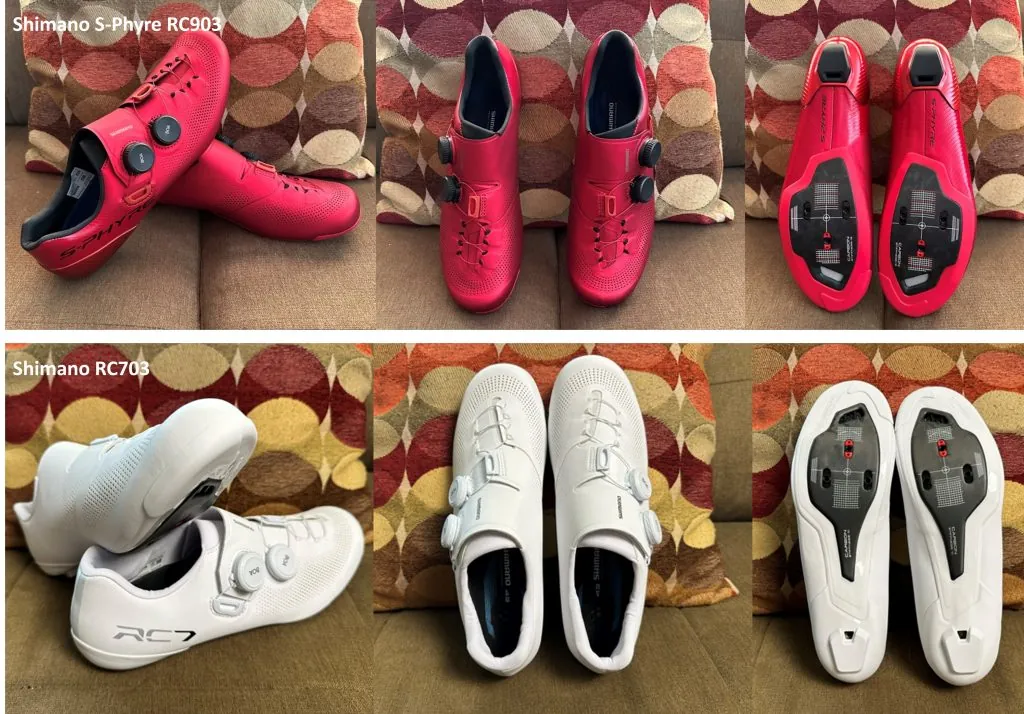
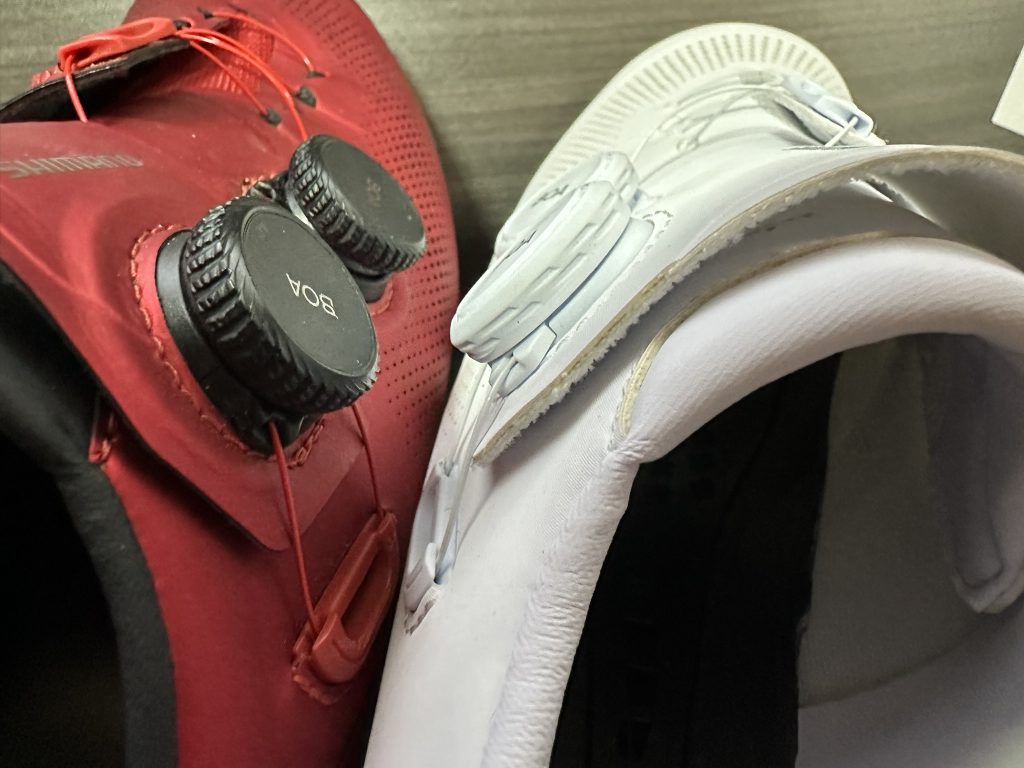
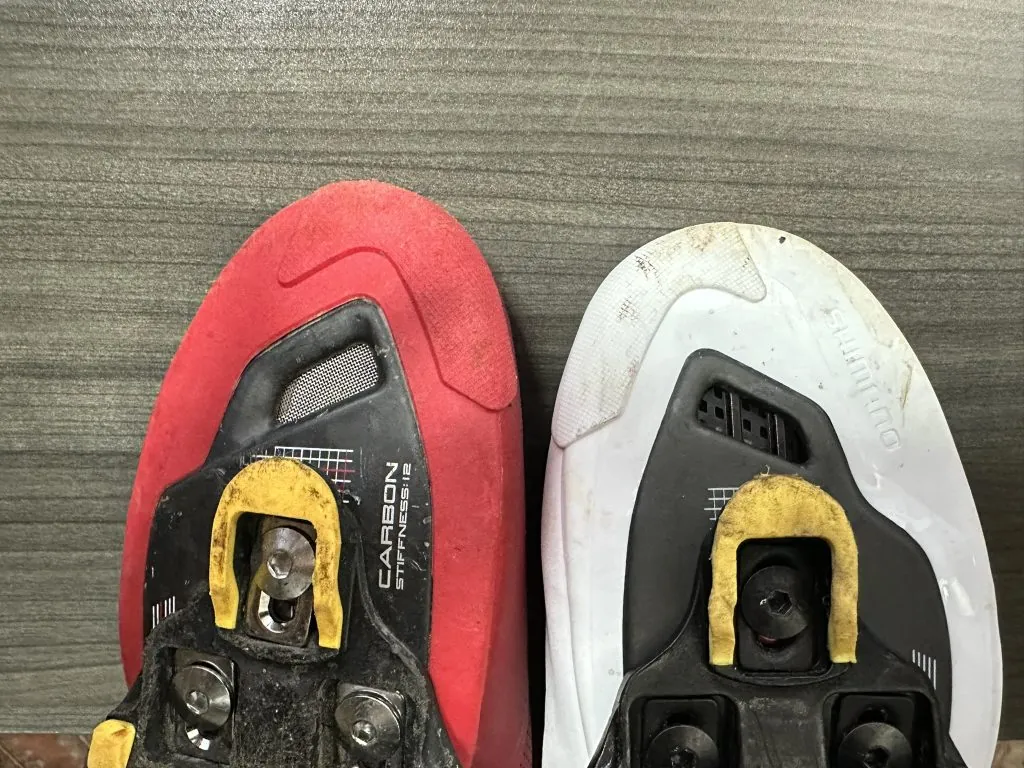
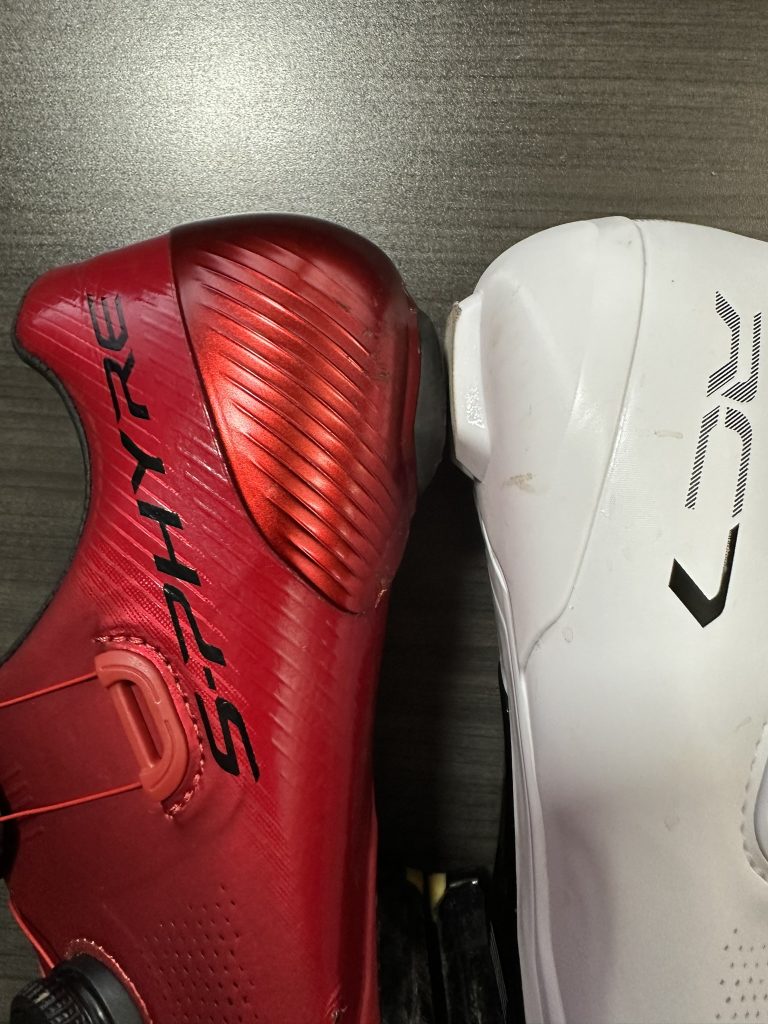
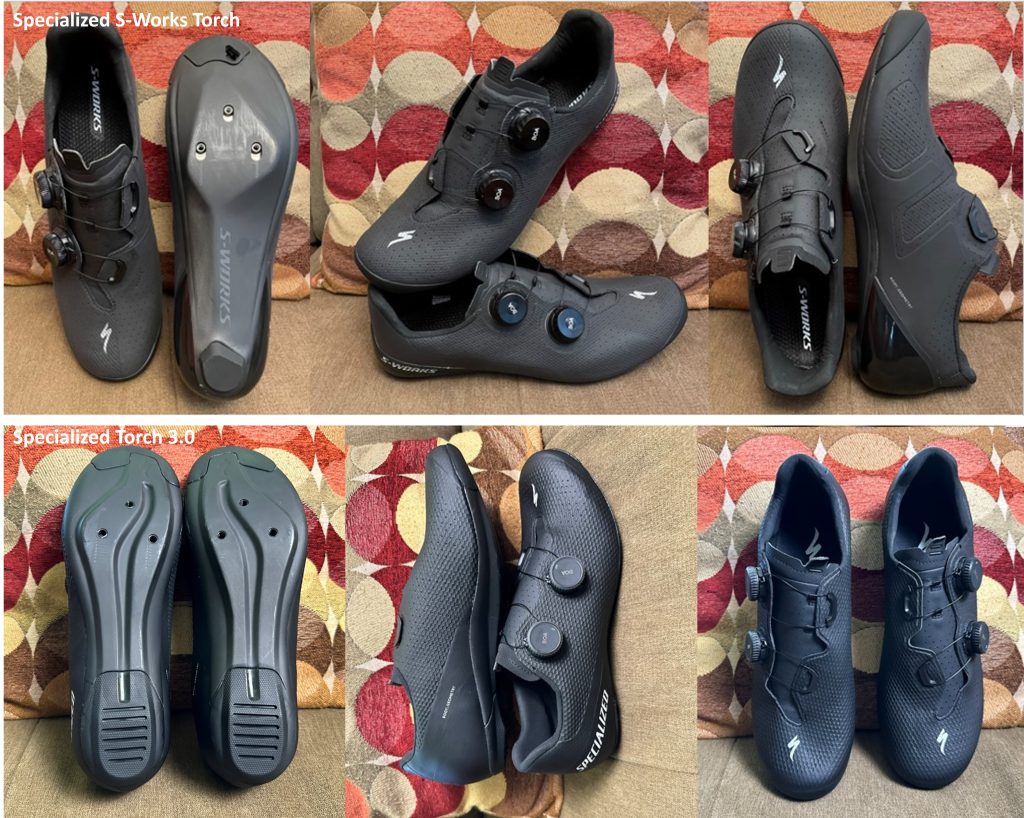
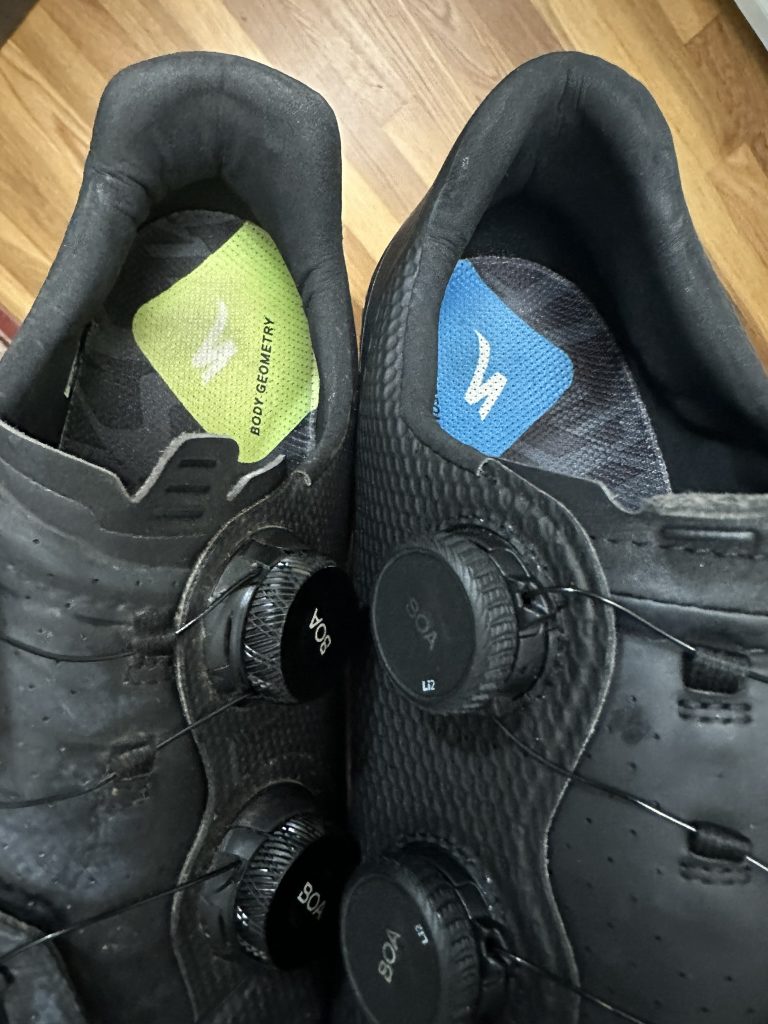
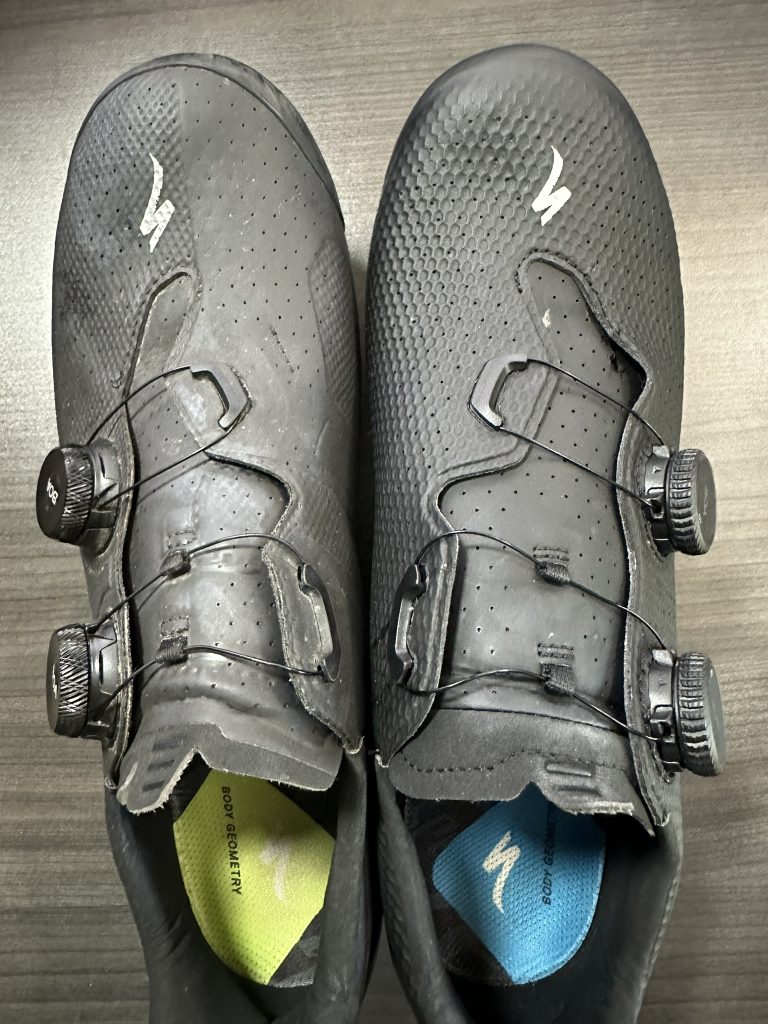
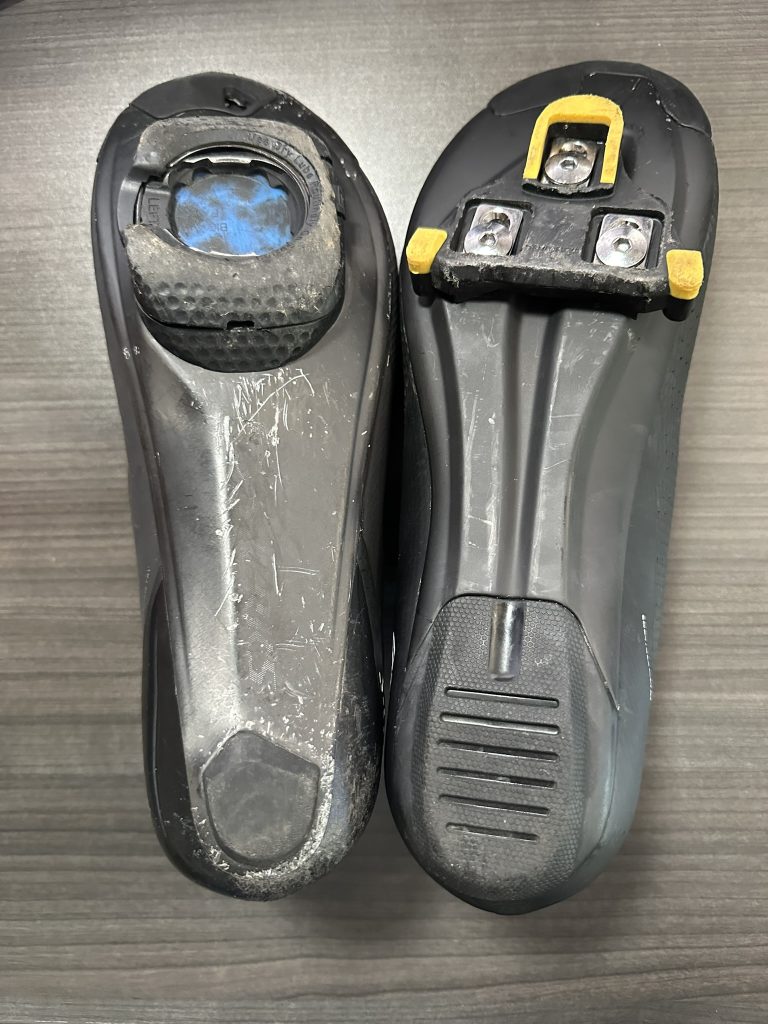
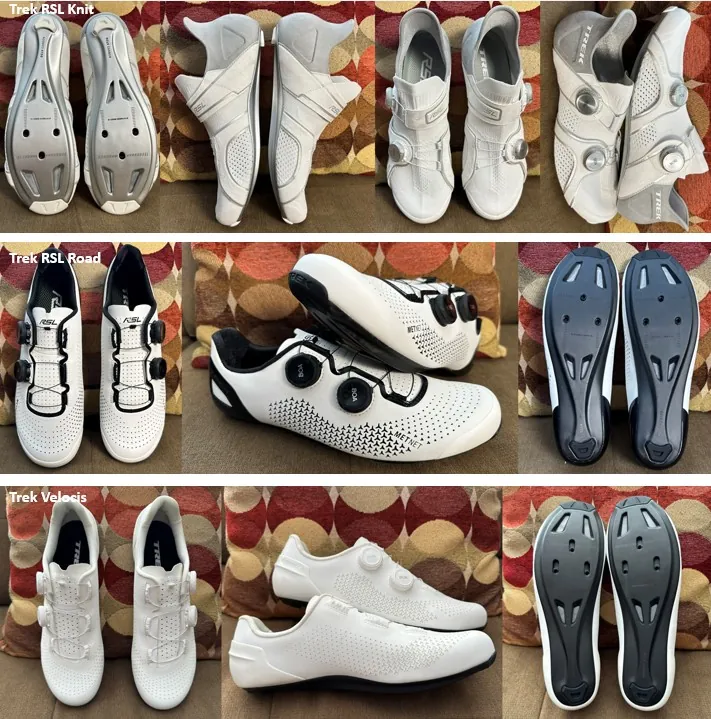

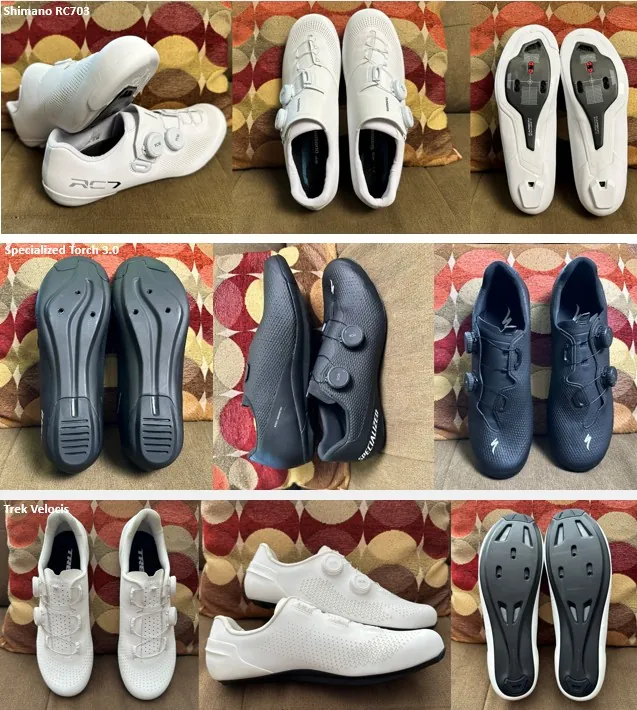
Most shoes only go to 48 at best which leaves me out since I’m a 49 wide. Lake shoes come in large and wide sizes and are at least as good a quality as any of these. Some of the recent Shimano shoes come in a 49 but not in wide, In fact strangely their wider shoes come in smaller sizes!
Can you speak to cleat placement on the three next-best shoes? From the pictures it looks like Shimano has much more rearward placement that the other two.
Mitchell, I can’t confidently speak to this. I take my shoes to my fitter who mounts my cleats for all of my road shoes. I’d probably f* my knees up if I did it myself. But, as you observed, there’s more room to slide the cleats back on the Shimano than the other two. Steve
Very nice take, as usual. Thanks for all the amazing writing job you do here 🙂
What is it that you have below the speedplay cleat in the last Sworks Torch picture ? The kind of blue/black swirl ?
Jeremy, thanks for your kind feedback. That’s a wedge Nate uses to adjust his fit. Steve
Great review , I like the look of the Velocis, I wish they made RSL in all white. I cant get pass the mix of white and black.
I havent seen the Velocis on Treks website yet
Stefano, it’s there at https://snp.link/18a8b758. Steve